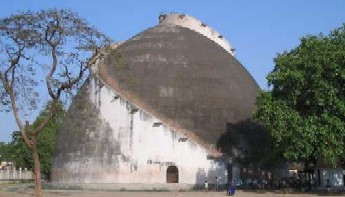|
|
|
|
|
|
|
|
|
|
|
Places to visit
in and around Patna
|
|
|
|
Agam
Kuan
Agam Kuan literally means "the unfathomable
well". It is a huge well dating from the period of
emperor Ashoka. The site is situated at a short distance
south-west of Gulzarbagh railway station. Agam Kuan is
circular in plan with a diameter extending over 20'
2". As many as eight arched windows, all at regular
intervals, adorn the well just above the ground and form
its most distinctive feature. The well is 105' deep, as
far has been fathomed and recorded. Upto a depth of 44'
from the surface, it has a finely worked brick-encasing.
The lower half, a further depth of 61' is, however,
secured by a series of wooden rings.
Waddell
on his exploration of the ruins of Patliputra during 1890s
identified Agam Kuan with the legendary hell built by
Ashoka for torturing people as cited by the Chinese
travellers of the 5th and 7th centuries A.D. Another
legend, still very strong, is that Ashoka threw 99 of his
elder brothers in this well after killing them, in order
to become king. The site also feeds the Jain legends. The
most famous of them is about a Jain Monk Sudarshana who,
when thrown into the well by an atrocious king Chand, was
found floating over its water seated on the lotus. People,
by and large, believe the well's water to be endowed with
miraculous power, and the well auspicious.
|
|
|

|
|
Kumhrar
Kumhrar, site of the ancient city of Patliputra, lies 5 kms from Patna railway
station. Archaeological findings in this area establish Patna's claim to over a
thousand years of political glory - 600 BC to 600 AD. Very little of this
grandeur remains though, except for the remains of a huge Mauryan hall supported
by 80 sandstone pillars dating back to 300 BC.
|
|
|
|

|
|
Gol Ghar
Gol Ghar, which means spherical building, was constructed by Captain John
Garstin in 1786. It was built in reaction to a famine in 1770 and has
beehive-like shape. It was used as a granary by the British. One can get a
complete panoramic view of Patna from top of the Gol Ghar. It, in a way,
symbolizes the identity of Patna.
It was inspired
by the native Stupa architecture of the ancient Indian tradition. Raised on a 2'
high plinth, the enormous dome, over a circular plan, raises well up to 96'. It
creates a wonderful echo effect from inside. The walls, all brick-masoned, with
its width of 12' 4", are no less impressive. Two spiraling stairways,
rising from the opposing sides, reach to the top, which has a small hole at the
centre (2' 7"). The doors at the bottom of the dome, are placed on all the
four cardinal directions, which opened originally from within. Two inscriptions,
one in English and the other in Persian rendering are affixed adjacent to each
other giving information about its construction.
|
|
|

|
|
Takhat
Sri Harimandar Ji Patna Sahib
Guru Gobind Singh, the tenth Guru of the Sikhs, was born in 1660 in Patna. The
Har Mandir Takht, one of the four sacred shrines of the Sikhs, stands at this
holy site. The original temple was built by Maharaja Ranjit Singh, and contains
belongings of the Guru and Sikh holy texts.
|
|
|
|
Next Page >>
|
|
|
|
|
|
|
|
|
|
|
|